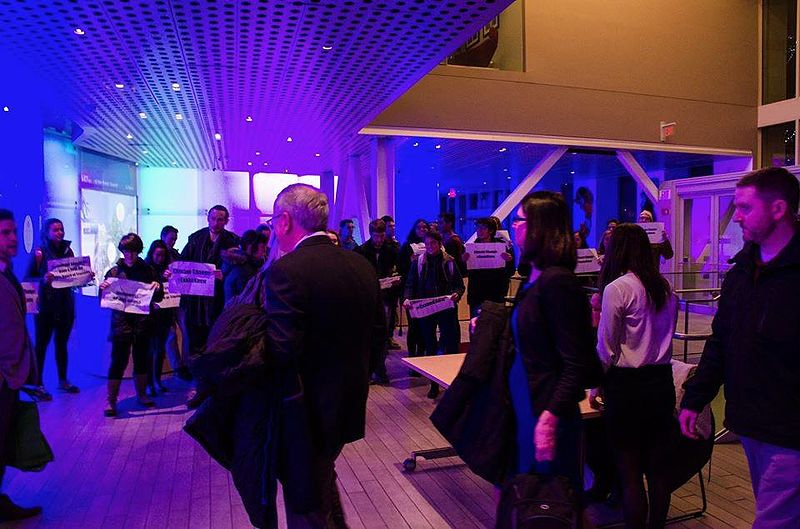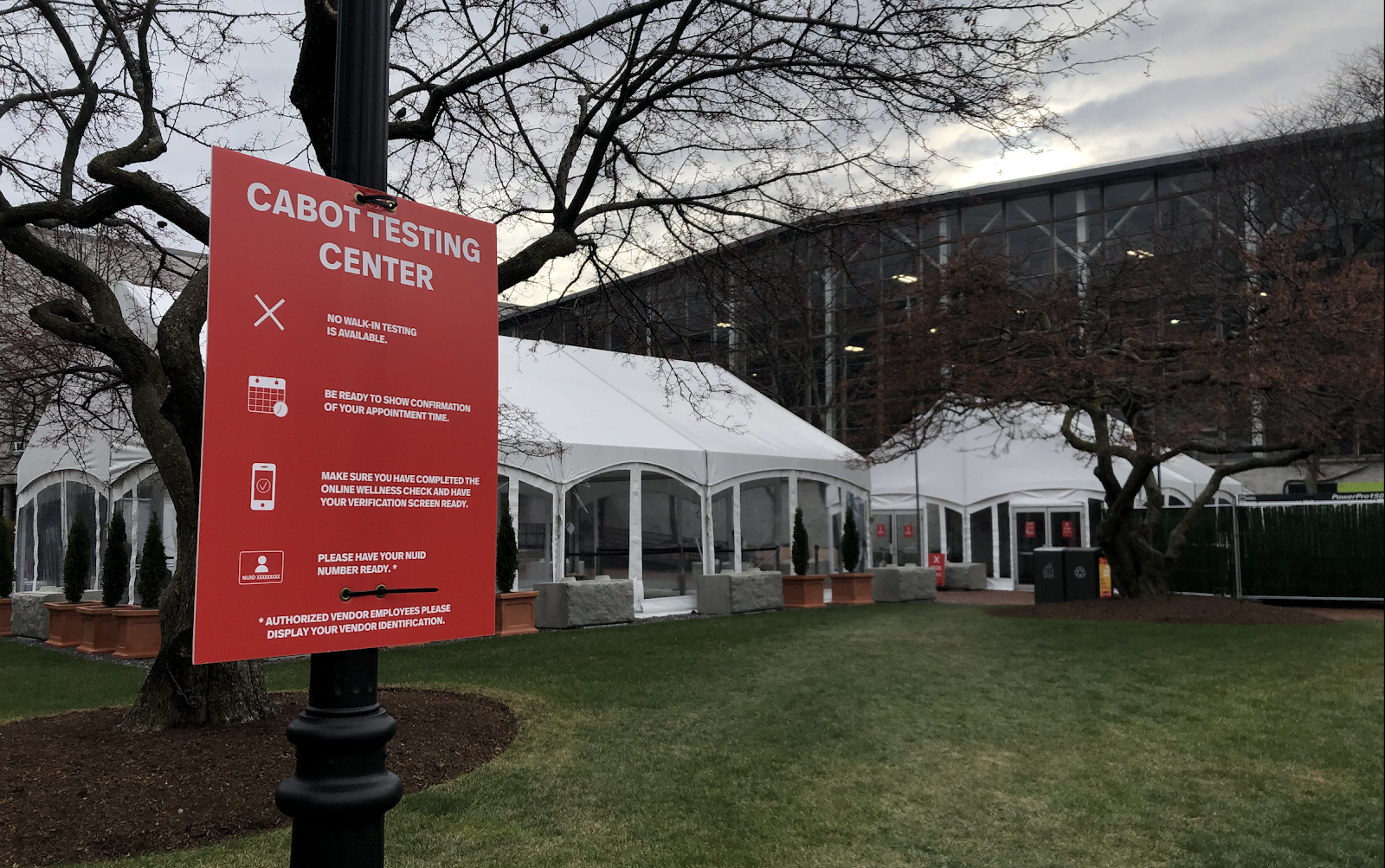Last month at Northeastern University, the adjunct union reached a tentative agreement with the university administration to avert a planned walkout after more than a year of unsuccessful negotiations. Those familiar with the adjunct campaign know that adjunct professors are contingent workers who comprise more than half of the teaching staff at Northeastern and are paid a couple thousand dollars for each class that they teach.[1] From a budgetary standpoint, contingent workers are economical because they are easily replaced and therefore can be paid less. Still, at a school like Northeastern University with an operating budget of more than $2.2 billion, it is hard to argue that more than half of all professors need to earn poverty wages for the school to remain profitable.[2]
In today’s neoliberal landscape—a term which refers to the coordinated effort by capital and financial interests after the 1980s to privatize public institutions and deregulate markets—Northeastern is not unusual in its treatment of adjunct professors. The neoliberal university model of high tuitions, bloated administrative departments, and upscale student facilities—along with assaults on the job security and pay of professors—is the new norm. It is the image of a thoroughly financialized economy that has transformed the relationship between universities and the state.
From the 19th century through the 1970s, the relationship between universities and the state remained constant. There was an informal arrangement of mutual independence: Academics operated autonomously with state funding on the understanding that they were willing to pursue research in which the state had an interest, such as medicine or space exploration.[3] Underlying this arrangement was the assumption that as a social good, education should drive public research and development.
The story of how universities became neoliberalized begins with the economic crisis of the 1970s and the subsequent free-market discourse that invoked capitalism’s insatiable need for economic growth in order to equate the interests of working people with the interests of financiers.
In the three decades after World War II, the U.S. established economic hegemony over the global capitalist world. The Fordist compromise between strong manufacturers and a strong, suburbanizing working class yielded unprecedented wage growth.[4] However, the Fordist model could not last forever. As a general rule, whenever compound economic growth falls below three percent, people begin to get scared. In order to sustain three percent compound growth, there must be no barriers to the continuous expansion and reinvestment of capital.
The suburbanization of postwar America did sustain high demand for American-made automobiles and home products, but reinvestment in manufacturing eventually became difficult for capital because a widely-unionized and militant working class created a labor shortage (i.e. near-full employment) which drove up wages and hurt profitability.[5][6] To the extent that productivity could be improved by technological innovations, organized labor insisted on “productivity agreements” that ensured that machines would not be used to undermine wages or benefits. To make matters worse for U.S. manufacturers, monopolies like the Big Three auto companies were broken by foreign imports from a newly rebuilt Europe and Japan.[7]
In The Grundrisse, Karl Marx remarked that “every limit [to capital accumulation] appears as a barrier to be overcome.”[8] For Marx, sustained capital accumulation requires an “industrial reserve army” to keep the cost of labor (i.e. wages) from impeding profitability. To restore profits, American capital had to discipline labor by drawing from the global working population. The Immigration and Nationality Act of 1965 addressed U.S. labor scarcity by abolishing immigration quotas based on nationality so that cheap labor would flood the market and drive down wages.[9] However, it proved more effective for manufacturing capital to simply relocate to countries with cheaper labor, and throughout the 1970s and 1980s capital did just that—first to South Korea and Thailand, and then to China as wages in those countries became too high.[10]
“Globalization” entailed removing barriers to international capital relocation such as tariffs and quotas in order to construct a global market where liquid money capital could flow internationally to wherever it yielded the most profits. Of course, wage suppression eventually lowers consumer demand. The neoliberal solution was for financial institutions to sustain middle-class purchasing power through credit. In The Enigma of Capital, David Harvey writes that “the demand problem was temporarily bridged with respect to housing by debt-financing the developers as well as the buyers. The financial institutions collectively controlled both the supply of, and demand for, housing!”[11]
The point of this history though, is that the financialization of the American economy, through which financial markets came to dominate other forms of industrial and agricultural capital, served as the backdrop for the transformation of higher education into what it is today. Neoliberal ideology reframed the social value of higher education as a tool for building the next workforce to serve the new “information economy”—a term that emerged in the midst of globalization to describe the role of U.S. suburban professionals in the global economy. Simultaneously, finance capital repurposed universities as points of capital accumulation and investment.
The discourse around the information economy sought to rationalize the offshoring of manufacturing from the U.S. The idea was that due to globalization, America has reached a stage of development where its participation in the global economy is as a white-collar work force, specializing in technology and the spread of information.[12] In this telling, there is nothing to critique about the deindustrialization of the American economy because it was inevitable. It was then simple to realign the social goals of universities with the economic goals of Wall Street because the state repression of radical civil rights movements on the Left and the emergent free-market discourse of the Right formed a widespread perception of the state as inherently problematic. State research and development at universities was easily dismissed as inefficient, which cleared space for a neoliberal redefinition of higher education.
Neoliberalism has transformed education from a social good into a production process where the final product is a reserve army of workers for the information economy. What David Harvey calls the “state-finance nexus” pushes universities to play the part by withholding state funds until they expand their enrollment and increase the number of college graduates entering the workforce.[13] In 2012, the Obama Administration identified increasing the number of undergraduate STEM degrees by one million over the next decade as a ‘Cross-Agency Priority Goal’ on the recommendation of the President’s Council of Advisors on Science and Technology (PCAST).
At the same time that neoliberalism transforms education into a production process for high-tech workers, it transforms the university itself into a site for surplus capital absorption through the construction of new labs, facilities, and houses to draw wealthy students and faculty capable of attracting federal grants. In December 2015, Northeastern filed a letter of intent with the Boston Redevelopment Authority to propose building a residence hall for approximately 800 students. The Boston Globe reported that the project is currently under review by American Campus Communities, the largest developer of private student housing in the U.S. To an economizing university administrator, private developers are very appealing because they assume the debt generated by construction projects. The circular process whereby a large university endowment comprised of financial assets is used to contract a debt-financed independent developer reveals how neoliberalism integrates universities into the circulatory system of capital as circuits of accumulation and investment.[14]
The present relationship between the university and the state flows from the dynamics of financialization. As financialization transforms the role of the United States in the global economy, it appropriates higher education to suit the needs of finance capital. Compared to the ever-expanding administrative apparatus responsible for managing contracts and investments, programs outside of STEM and business fields are considered superfluous. Humanities programs are often downsized and tenure tracks closed to push professors into permanent part-time employment arrangements.[15] Meanwhile, schools like Northeastern and MIT are surrounded by high-tech and business firms that rely on students and research facilities for cheap labor and productive capital.
The position of financial and credit institutions as the financiers of America’s productive infrastructure has far-reaching consequences for social institutions like universities with the potential to absorb surplus capital in the form of credit or produce the 21st-century ‘information’ workforce. Students, and faculty at universities like Northeastern will struggle against market pressures on universities to attract outside investors while downsizing education for as long as the U.S. economy is dominated by finance.
References:
[1] “Northeastern University Adjunct Faculty Union.” Northeastern University Adjunct Faculty Union. http://www.nuadjuncts.org/#!gss-support-letter/c1j06. Pricewaterhouse
[2] Coopers LLP. “Consolidated Financial Statements June 30, 2013 and 2012.” Northeastern University. June 30, 2013. http://www.northeastern.edu/finance/pdfs/financials-FY2013.pdf.
[3] Berman, Elizabeth Popp. Creating the Market University: How Academic Science Became an Economic Engine. Princeton: Princeton Univ. Press, 2015.
[4] “Raising America’s Pay: Why It’s Our Central Economic Policy Challenge.” Economic Policy Institute. Accessed January 29, 2016. http://www.epi.org/publication/raising-americas-pay/.
[5] “NACS 50th Anniversary – 1960s: Developing Critical Mass.” NACS 50th Anniversary – 1960s: Developing Critical Mass. Accessed January 29, 2016. http://www.nacs50.com/decades/60s/.
[6] Hirsch, Barry T. “Union Coverage and Profitability Among U.S. Firms.” The Review of Economics and Statistics 73, no. 1 (1991): 69.
[7] Harrison, Andrew L. Business Environment in a Global Context. Oxford: Oxford University Press, 2010.
[8] Marx, Karl. The Grundrisse.
[9] “Public Law 89-236: An Act to Amend the Immigration and Nationality Act, and for Other Purposes. Stat. 79.” https://www.gpo.gov/fdsys/pkg/STATUTE-79/pdf/STATUTE-79-Pg911.pdf.
[10] Hung, Ho-fung. The China Boom: Why China Will Not Rule the World.
[11] Harvey, David. The Enigma of Capital: And the Crises of Capitalism. Oxford: Oxford University Press, 2010.
[12] Drucker, Peter F. The Effective Executive. New York: Harper & Row, 1967.
[13] “State Higher Education Finance FY 2013.” State Higher Education Executive Officers. http://www.sheeo.org/sites/default/files/publications/SHEF_FY13_04172014.pdf.
[14] Whitener, Brian, and Dan Nemser. “Circulation and the New University.” Reclamations Blog. 2012. Accessed January 29, 2016. http://www.reclamationsjournal.org/blog/?p=596.
[15] “Instructional Staff Report.” American Association of University Professors. http://www.aaup.org/sites/default/files/files/AAUP_Report_InstrStaff-75-11_apr2013.pdf.



